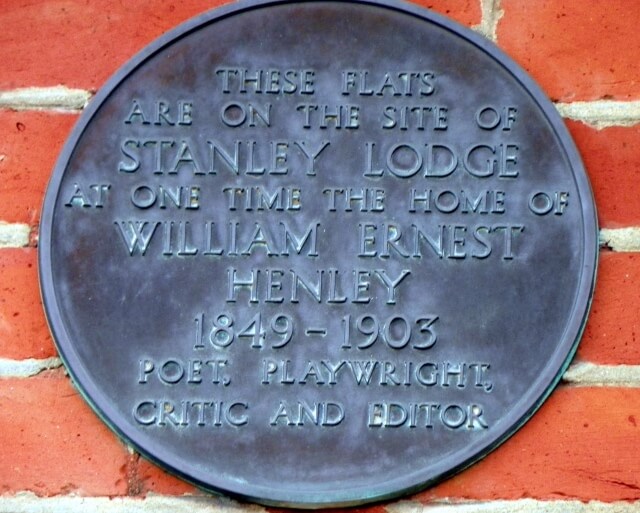
William Ernest Henley (1849 – 1903) was an English poet, critic and editor of a series of literary
magazines and journals. He was able to choose his contributors to these and he included his own essays, criticism, and poetic works also. Through these journals he introduced the early work of many of the great English writers to late Victorian England. He was said at the time to have had as central a role in influencing culture and literary perspectives, as had Samuel Johnson in the 18th century.

Henley lived in Muswell Hill for two years from Easter 1896. He moved into a property in Tetherdown (formerly Tatterdown) which was designed to be a public house but became instead Stanley Lodge. Tetherdown had developed in the late 1870s and ‘80s on both sides of the road with smaller houses on the west side (one with an 1873 date stone) and large villas on the east side, such as Thorntons which was absorbed into Tollington Boys’ School when it was built in front of it and is now part of Fortismere School. ’We are victims of the British Builder’, he wrote on arrival in his rented property, ‘but the house shapes gallantly, all the same …The Bar (for instance) is already on the spot; and so are the Tap-Rooms – whence I write’. The house has been rebuilt and is now a block of flat named Nayland Rock, Nos. 80-82 Tetherdown.
Son of a Gloucester bookseller, Henley had contracted a tubercular disease of the bone as a child which necessitated the amputation of his left leg below the knee when he was a young man. His early years were marked by periods of extreme pain due to the draining of his tuberculosis abscesses. His other leg was saved only through the skill and radical new methods of the surgeon Joseph Lister, whom he sought out in Edinburgh. Forced to stay in an infirmary in Edinburgh for 20 months (1873–75), Henley began writing impressionistic poems, some in free verse, composed during his isolation as a consequence of his life-threatening battles with tuberculosis. These ‘hospital poems’ established his reputation as a poet.
His most remembered ‘hospital poem’ is Invictus, (Latin for ‘unconquerable’ or ‘undefeated’), written in 1875 and published (1888) in his Book of Verses, in the section Life and Death (Echoes). It is set out below:
Out of the night that covers me
Black as the pit from pole to pole,
I thank whatever gods may be
For my unconquerable soul.
In the fell clutch of circumstance,
I have not winced nor cried aloud.
Under the bludgeonings of chance
My head is bloody, but unbowed.
Beyond this place of wrath and tears
Looms but the Horror of the shade,
And yet the menace of the years
Finds, and shall find, me unafraid.
It matters not how strait the gate,
How charged with punishments the scroll,
I am the master of my fate:
I am the captain of my soul.
The first Invictus Games, an international multi-sport event for wounded, injured or sick armed services personnel and their associated veterans, started by Prince Harry, Duke of Sussex, took place in September 2014.
Henley’s long, close friendship with Robert Louis Stevenson, the Scottish novelist, began in 1874 when W.E. was still a hospital patient; Stevenson is said to have based Long John Silver in Treasure Island on his friend. Henley and his wife had a daughter Margaret (b.1888). She was a sickly child, and became immortalized by J.M. Barrie in his children’s classic, Peter Pan. Unable to speak clearly, young Margaret called her friend Barrie her “fwendy-wendy”, resulting in the name ‘Wendy’ in the book. Sadly, Margaret did not survive long enough to read the book; she died on 11 February 1894 at the age of five.
After two years in Tetherdown, Muswell Hill, WE Henley moved to the south coast. In 1902, he fell from a railway carriage, the accident causing his tuberculosis to flare up again. He died of it on 11 July 1903, at the age of 53, at his home in Woking, Surrey. His ashes were interred in Margaret’s grave in Cockayne Hatley churchyard, Bedfordshire.
As we have seen, Henley’s early years of pain and long periods in hospital, where he observed death at first hand, left its mark in his remarkable stoicism, cheerfulness, yet morbid interest in death. Interestingly, Stanley Lodge in Tetherdown was directly opposite a house called Muswell Lodge (now Burlington Road). In February 1896, only two months before Henley arrived in Muswell Hill, the infamous, brutal murder of Henry Smith, had taken place in that house. After a sensational trial, Smith’s killers, Milsom and Fowler, were hanged in June of that year. The murder attracted extensive coverage in the press and thousands of people turned up in Muswell Hill to view the scene of the crime. Did this attract Henley to sparsely populated Muswell Hill?
In his book, A History of Muswell Hill, HHS, 2013, Ken Gay refers to Henley’s time in Muswell Hill and to the history of its development which have put Muswell Hill ‘on the map’.
Image credits
Plaque on the wall of Nayland Rock – courtesy of Lesley Ramm; Nayland Rock 2021 – courtesy of Janet Owen.